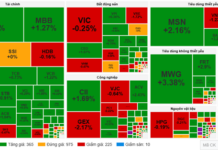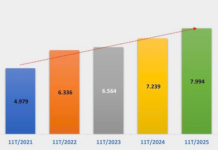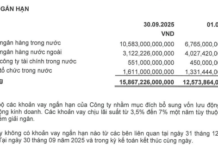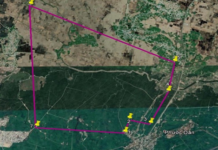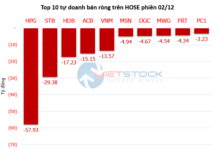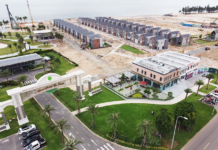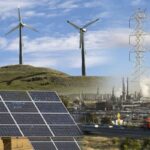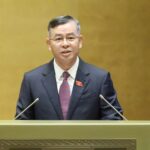
Image: Construction site of Belt road 3 in Ho Chi Minh city. Source: Construction newspaper.
Among the 3 strategic breakthoughs including: institution, infrastructure and human resources, the breakthrough in infrastructure, especially transportation infrastructure in recent years has been changing the face of the country. Because transportation is the “lifeline” of the economy.
So far, according to the report of the Ministry of Transport, the East-West North-South highway project has completed 9 out of 11 component projects in the period of 2017 – 2020 and the My Thuan – Can Tho bridge project according to the plan, raising the total length of highway to 1,892 km, of which only in 2023 is 475 km; the remaining 2 projects are to be invested under BOT contracts.
In addition, other highway projects such as the Tuyen Quang – Ha Giang section passing through Ha Giang province; Cao Lanh – An Huu; Ben Luc – Long Thanh are being implemented by investors and contractors closely following the set schedule. As for the urban railway project Nhon – Hanoi station and the Ben Thanh – Suoi Tien project, they are being reviewed by Hanoi and Ho Chi Minh city, removing obstacles in the contract, carrying out personnel training, completing procedures related to fire prevention, fire fighting, construction acceptance, safety system certification in order to strive for the operation of the Nhon – Hanoi station section and the Ben Thanh – Suoi Tien project in July 2024.
Regarding the Long Thanh international airport project, the bidding packages are being organized for construction such as the package 5.10 Passenger terminal, construction package for facilities serving flight management have been instructed by Vietnam Airport Corporation (ACV), Vietnam Air Traffic Management Corporation (VATM) for contractors to closely follow the progress. Bidding packages that have not started construction belong to component project 1 to build headquarters of state management agencies, component project 4 to build essential works are being implemented by management agencies for investment procedures; selecting investors. The bidding package T3 Passenger terminal of Tan Son Nhat International Airport is being implemented and closely following the set schedule by ACV, with disbursement reaching 2,477/10,825 billion VND (23%).
This shows that accelerating public investment, mainly in transportation infrastructure, creates favorable conditions for the country’s socio-economic development. Especially in 2024, the whole country has allocated 657,000 billion VND for public investment, mainly in transportation infrastructure, and strives to achieve a disbursement rate of at least 95%.
According to experts’ assessments, concentrating on disbursing public investment, with the operation of transportation projects, will contribute to reducing logistics costs for businesses, reducing input costs, increasing the competitiveness of products, businesses and the economy; creating new development spaces because wherever the path leads, it opens up new development spaces, especially industrial development, urban areas, and services.
Transportation expert Nguyen Van Quyen believes that the development potentials of the country can be realized depending largely and directly on the transportation system. Transportation development reduces logistics costs for businesses, increases the competitiveness of Vietnamese goods and services.
According to Mr. Quyen, if we focus on investing in major transportation works, we can create connectivity and diffusion and tap into the advantages and potentials of the country, creating new impetus for development.
“If we increase public investment in transportation infrastructure, it will help increase the disbursement rate of public investment capital in 2024, and at the same time create employment opportunities for workers, exploit the potential advantages of land, reduce logistics costs, increase the competitiveness of goods in general, and have a dual impact on many aspects of the economy. Because investing in a project can take several years to be effective, but investing in transportation projects you can see the diffusion and effectiveness immediately” – Mr. Quyen expressed.
Assoc.Prof.Dr. Dinh Trong Thinh (Finance Academy) analyzed that in recent years, we have increased investment in developing key transportation works and have achieved good results. In 2023, nearly 500 km of expressway were completed, and in the next 1-2 years we will see clear effectiveness.
In addition to public investment in transportation infrastructure, according to Mr. Thinh, attention should also be paid to the development of other infrastructures such as high-tech infrastructure. Public investment in 2024 and 2025 should take steps to create a transition, from which create economic transformation in the period of 2021-2025, from then on starting from 2026-2027 we will have a new foundation for high labor productivity, efficiency.
“At the end of 2023, early 2024, many foreign investors coming to Vietnam are investing in semiconductor production, chips, electronic components, they want us to become a place to provide semiconductors and chips for the world. If we do not create infrastructure from transportation to electricity infrastructure, internet, it will be difficult to attract investors” – said Mr. Thinh.
It is also noteworthy that at the workshop on the development of urban railway systems in Hanoi and Ho Chi Minh City, Prof. Vu Minh Khuong – University of Public Policy Quang Duc (Singapore) said that traffic congestion costs New York 11 billion USD, Los Angeles costs 8.2 billion USD, and Chicago costs 7.6 billion USD each year.
Khuong warned that Hanoi and Ho Chi Minh City will suffer greatly if they do not pay special attention to the development of urban railway systems, in which each locality will bear a minimum damage of 2-3 billion USD per year due to traffic congestion. Therefore, investing in transportation infrastructure is a matter of urgency.
“
On February 16, at an online meeting with 46 provinces and centrally-run cities having important national projects, important national projects, and key transport sectors, Prime Minister Pham Minh Chinh – Head of the State Steering Committee for important national projects, important national projects, and key transport sectors emphasized: In the past few years, investment and development of transportation infrastructure have been promoted, creating a trend, a momentum, not only by the central but also by localities. 2021-2022 is a period of starting, preparing and approving projects, 2023 is the period of simultaneous implementation, 2024 is determined as the year to accelerate the implementation of major transportation works.”


